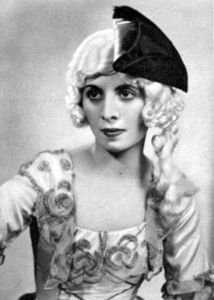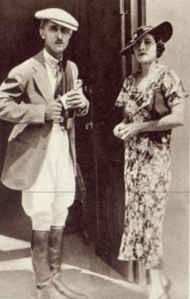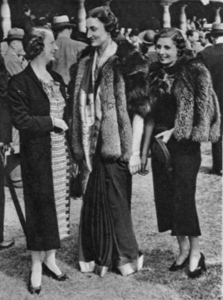Bhicoo Batlivala
Bhicoo Batlivala | |
|---|---|
Bombay, British India | |
| Died | 10 October 1983 (aged 72) , West Sussex, England |
| Other names |
|
| Alma mater | Cheltenham Ladies College |
| Occupation | Barrister |
| Known for |
|
| Spouse |
Guy Robinson Mansell
(m. 1939) |
| Children | 2 |
Bhicoo Batlivala (13 October 1910 – 10 October 1983), also known as Mrs. Guy Mansell or Bee Mansell, was an Indian-born British barrister and campaigner for
She first appeared in the 1930s as a popular socialite and photographs of her appeared in several magazines including Tatler and The Sketch. In 1935, after working as a barrister at the Inner Temple, the Maharaja of Baroda in Gujarat, appointed her as the first female to work for its State service, where she became an advocate for the education of women. For a short while, she was personal secretary to Jawaharlal Nehru during his European tour of 1938. She would later campaign for the release from prison of both Nehru and Mahatma Gandhi, and at one time led a delegation of Indian women into the House of Commons to speak to women MPs there. Her earlier tour of the United States, to talk about India, gave British government intelligence significant concern.
In 1962, after settling in Cobham with her family, she founded Cobham Hall School.
Early life and education
Bhicoo Batlivala was born in
Career
Batlivala worked for a few years as a barrister at the Inner Temple before the Maharaja of Baroda in Gujarat, India, appointed her as the first female to work for his State service in 1935.[3][7] There, she assisted the education minister in matters relating to educating women.[3][7]
In 1938, after her engagement to Guy Robinson Mansell in England,
United States tour 1939-40
British government intelligence became concerned after noting that she regularly attended meetings of the India League and had planned a US tour.[11] She departed Southampton for New York on 19 December 1939 on the Holland America Line's SS Volendam.[12] While in the US, her views on British rule were criticised by the prominent opponent of Indian independence Katherine Mayo.[13] In 1940, Batlivala completed the six-month lecture tour.[11] Other Indian women seeking to gain American support around that time included Sarojini Naidu, Vijaya Lakshmi Pandit,[14] and Kamaladevi Chattopadhyay, who was lecturing on India at the same time.[15] One of the schools she visited was Waterville High School, Waterville, Maine.[16] It was reported in one newspaper that "no other speaker who has appeared at the Washington Athletic Club has carried the enchantment, the fascination, the brilliance and stimulation that 28-year-old Bhicco Batlivala does".[1]
Release Nehru and Mahatma Gandhi campaigns
Professor of American literature
On 24 February 1943, the press reported that day that Batlivala headed a group of Indian women and led them to the Central Lobby of the
Socialite
Batlivala first appeared in the 1930s as a popular socialite.
-
Batlivala dressed as actress Pola Negri (1933)
-
Batlivala at a polo match at Wilmer House, Ham Common, London (1935)[26]
-
Batlivala withKashmir State Force. (1935)
-
Batlivala with Sir Basil Brooke (1936)
Later life
In 1946, she was registered as residing at Chestnut Lodge, Old Common Cobham, Cobham, Kent.[36][b] In 1962, she founded Cobham Hall School.[5][38] According to the founding headmistress, Brenda Hancock, Batlivala had been deeply offended by a refusal from the then head of Cheltenham Ladies College to meet Batlivala's seven-year-old daughter, that upon a suggestion, she decided to start her own school and persuaded Pandit to be its patron.[5] Other supporters were Sir John Rothenstein and Sir Malcolm Sargent.[39]
Personal and family
She married Guy Robinson Mansell of Upton, Buckinghamshire,[3] in 1939.[11][c] They settled in Cobham, Surrey, and had a son, Guy, and a daughter, Edwina.[41]
Death
Batlivala died on 10 October 1983 in a nursing home at Burgess Hill, West Sussex.[42] A memorial plaque was put up at Cobham Hall School following her death.[43]
Explanatory footnotes
- ^ Other Indian aviators around at the time included Man Mohan Singh, Aspy Engineer, and her relation J. R. D. Tata.[27]
- ^ It became a Grade II listed building in 1969.[37]
- ^ The England and Wales, Civil Registration Marriage Index, 1916–2005, records their marriage in Westminster in 1939, but spells her name 'Blicoo'.[40]
References
- ^ a b c d e f "Bhicoo Batlivala | Making Britain". www.open.ac.uk. Archived from the original on 2 September 2022. Retrieved 25 August 2022.
- ^ "Wokingham 1946". 1939 England and Wales Register. 1946. Retrieved 2 September 2022 – via ancestry.co.uk.
- ^ a b c d e f g h "Parsee woman barrister's romance". Dundee Evening Telegraph. 28 January 1938. p. 6 – via British Newspaper Archive.
- ISBN 978-1-906165-25-3.
- ^ ISBN 978-1-68348-476-9.
- ^ "Bar examinations: women's successes". Vote. 17 January 1930. p. 22 – via British Newspaper Archive.
- ^ a b "Women's work for women in India". Birmingham Daily Gazette. 2 December 1935. p. 6 – via British Newspaper Archive.
- ^ "Getting married". The Bystander. 16 February 1938 – via British Newspaper Archive.
- ISBN 978-0-19-510073-0.
- ^ "Previous Speakers". Crichton Club. Retrieved 29 August 2022.
- ^ a b c d O’Brien, John (25 September 2021). "Bhicoo Batlivala: The forgotten freedom fighter whose US tour made the British government anxious". Scroll.in. Archived from the original on 26 August 2022. Retrieved 26 August 2022.
- ^ "Outward passenger list from Southampton". UK and Ireland, Outward Passenger Lists, 1890-1960. 1939. Retrieved 2 September 2022 – via ancestry.co.uk.
- ^ "RP XXV.1.273 (1-5) - Letters to Elena Richmond from Ruth Draper, America". sca-archives.liverpool.ac.uk.
- ISBN 978-81-230-2577-3.
- ISBN 978-93-85932-35-9.
- ^ "Bhicoo Batlivala tells of East Indian customs". The Colby Echo. Waterville, Maine. 7 February 1940.
- ^ ISBN 978-1-906165-25-3.
- ^ "Article". The International Women's News. 3 January 1941. p. 51 – via British Newspaper Archive.
- ^ ISBN 978-0-19-806537-1.
- ^ ISBN 0745313787.
- ^ "H. G. Wells | Making Britain". www.open.ac.uk. Retrieved 28 August 2022.
- ^ a b c "Gandhi is cheerful". Derby Daily Telegraph. 24 February 1943. p. 51 – via British Newspaper Archive.
- ^ "24 February Newspapers". British Newspaper Archive. 24 February 1943.
- ^ "A reception at Overseas House". Tatler. 15 July 1936. p. 126 – via British Newspaper Archive.
- ^ a b "Mayfair gossip: a charming Parsee". Belfast Newsletter. 27 May 1932. p. 6 – via British Newspaper Archive.
- ^ a b "Ladies polo at Wilmer House, Ham Common". Tatler. No. 1828. 8 July 1935. p. 70 – via British Newspaper Archive.
- ISBN 978-1788037-983.
- ^ "Do you think they are like your favourite film stars?". The Sketch. 17 May 1933. p. 283 – via British Newspaper Archive.
- ^ "Prince George among the dancers at the Derby Ball". The Sketch. 13 June 1934. pp. 272–273 – via British Newspaper Archive.
- ^ "Notable polo players and spectators". The Sketch. 23 June 1937. p. 611 – via British Newspaper Archive.
- ^ "Savitri". Civil & Military Gazette. Lahore. 23 April 1935. p. 3 – via British Newspaper Archive.
- ^ "Women's Congress in Turkey". The West Australian. 12 February 1935.
- OCLC 825553863.
- ^ "Polo Notes". Tatler. No. 1774. 10 July 1935. p. 70 – via British Newspaper Archive.
- ^ "Ascot's Elite, Rained Out, Finds Solace at Parties; Queen Makes Visit Despite Downpour—Races Put Off". The New York Times. 19 June 1964. Archived from the original on 26 August 2022. Retrieved 26 August 2022.
- ^ "Epsom 1946". Surrey, England, Electoral Registers, 1832-1962. 1946. Retrieved 2 September 2022 – via ancestry.co.uk.
- ^ "Chestnut Lodge, Cobham, Surrey". britishlistedbuildings.co.uk. Retrieved 2 September 2022.
- ^ Carrum, Antony (8 February 1962). "A school with no jolly hockey sticks". Daily Herald. p. 3 – via British Newspaper Archive.
- ^ "New girls school". Birmingham Daily Post. 8 February 1962. p. 8 – via British Newspaper Archive.
- ^ "Marriages". England & Wales, Civil Registration Marriage Index, 1916–2005. 1939. Retrieved 28 August 2022 – via ancestry.co.uk.
- ^ "Polo at Cowdray". The Sketch. 10 August 1955. p. 105 – via British Newspaper Archive.
- ^ "Deaths 1939". England & Wales, National Probate Calendar: Index of Wills and Administrations (1858-1995). 1984. p. 6039. Retrieved 28 August 2022 – via ancestry.co.uk.
- ^ "Cobham Hall School Gravesend Cobham". www.educationbase.co.uk. Retrieved 29 August 2022.
External links
- "Batlivala, Bhicoo. 'Civil Liberties in India'". Yale University Library.


![Batlivala at a polo match at Wilmer House, Ham Common, London (1935)[26]](http://upload.wikimedia.org/wikipedia/commons/thumb/c/c8/Bhicoo_%28Bee%29_Batlivala_%281935%29.png/208px-Bhicoo_%28Bee%29_Batlivala_%281935%29.png)


